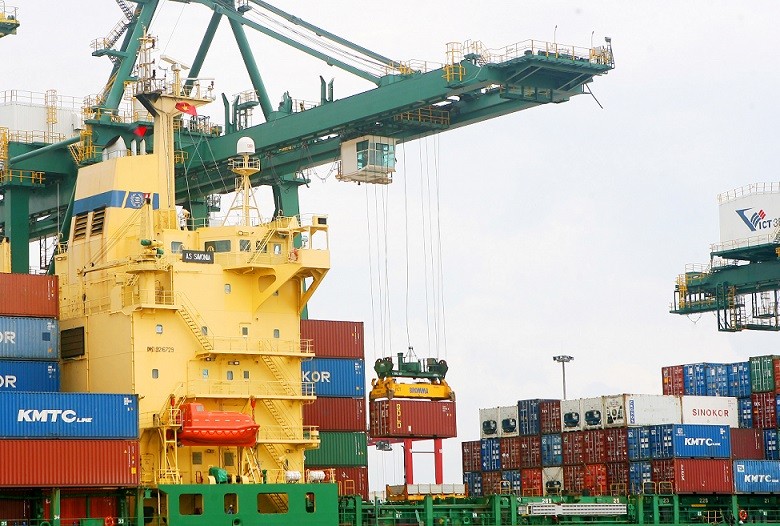The National Assembly Economic Committee (NAEC) reported at the National Assembly (NA) that in the second quarter of this year, the country’s trade situation will not be able to become better because of continued shortages of export orders, and if there are orders, they are just of small scale with a limited number and low values, and the situation will continue lasting until the end of the third quarter of this year.
The government set a target earlier, that this year, Vietnam’s total goods export-import value will be about 795 billion USD, a year-on-year of about 8%. The export turnover will be 398 billion USD – up over 8%. The trade surplus will stay at about 1 billion USD, much lower than the 11.2 billion USD recorded last year.
However, the government last week reported to the NA that since early this year, Vietnam’s key and traditional export markets have been shrinking, and many exporters in the nation have been suffering from serious shortages of export orders. This has made it difficult for achieving the export goal for 2023.

The global economy’s slow-paced recovery is set to make a dent in Vietnam’s exports.
In the first five months of this year, the entire economy raked in an estimated 136.17 billion USD in export value, down 11.6% as compared to the corresponding period last year. Vietnamese enterprises’ turnover hit nearly USD 35.2 billion or a year-on-year reduction of 5.9% and foreign-invested enterprises (FIEs) turnover including crude oil export turnover, sat at nearly 101 billion VND or falling 11.1% year-on-year.
Mobile phones and their spare parts, about 90% from the Republic of Korea’s Samsung, are reported to reach a five-month export turnover of 21.178 billion USD, down 16% year-on-year.
Meanwhile, electronics, computers, and their spare parts have hit a total five-month export turnover of 20.33 billion USD – down 9.8% as compared to that in the same period last year.
Vietnam’s key export markets include the US, China, and the eurozone, and the Economist Intelligence Unit Limited has forecasted that their growth rates this year may stand at 0.7, 5.7, and 0.7%, respectively.
Last year, Vietnam’s export turnover from these markets reached 109.1 billion USD, 58.4 billion USD, and 47.1 billion USD – up 13.3, 4.5, and 17.4%, respectively.
In the first five months of this year, the figures hit 37.2 billion USD, 19.8 billion USD, and 18.5 billion USD, all down 19.5, 9.3, and 6.5%, respectively, as compared to the same period last year.
State-owned Vietnam National Textile and Garment Group (Vinatex) reported that since 2008, when the global financial crisis broke out, its fourth-quarter export turnover suffered from a year-on-year decline of 19% – standing at 8.6 billion USD. This drop is bigger than the year-on-year fall of 12% in the economy’s export turnover.
“This is the consecutive second quarter that the Vietnamese garment and textile industry suffered from a year-on-year reduction since the last quarter of 2022, in which exports to the US went down by more than 30%, with a total value of about 1.5 billion USD – meaning a year-on-year reduction of 500 million USD in each month in the first quarter of this year,” Vinatex reported.
Other garment and textile exporting nations in the world also shared the same grey situation. For example, China’s and India’s both reduced by 19% year-on-year, while Pakistan’s and Cambodia’s plummeted by 25-30%, and Bangladesh, which was the sole garment and textile exporter in the world to keep export growth last year, also suffered from a year-on-year drop of 2.5% in March.
“It is expected that Vietnam’s garment and textile export orders in the second and third quarters of this year will continue facing massive difficulties, with an expected reduction of 25–30% as compared to the same periods last year,” Vinatex said.
The Vietnamese government has also reported to the legislative body that Vietnam’s imports of crucial production materials in the first four months of this year are estimated to reduce by 15.7% year-on-year. In which, FIEs’ witnessed a year-on-year reduction of 15.1%.
“This is due to a slash in export orders caused by economic difficulties in the world economy and the tightened monetary policy in Vietnam’s export markets, where consumers have been forced to cut down on their unnecessary expenditures,” the government reported.
NAEC Chairman Vu Hong Thanh noted, “With existing difficulties in the world economy and a reduction in Vietnam’s import of production materials and FIEs’ imports, the country’s export-import outlook in the coming months will face massive difficulties, meaning negative impacts on the entire economy’s growth.”
“In this context, effectively taking advantage of already-inked free trade agreements (FTAs) is important. However, a recent number of studies of the Vietnam Chamber of Commerce and Industry (VCCI) have shown that the Vietnamese economy and enterprises have failed to take advantage of the FTAs as desired,” Thanh said.
Specifically, under a VCCI survey, “Do not know about FTAs’ benefits” is always one of the biggest reasons behind enterprises’ failure in benefiting from FTAs, and it only follows the reason of “Having no real transaction with FTA partners”.
In addition, a reduction in Vietnam’s index for industrial production (IIP) has also had negative impacts on the country’s export-import landscape.
According to the General Statistics Office (GSO), Vietnam’s index for industrial production (IIP) in the first five months of this year dropped 2%, as compared to the same period last year, when the IIP increased 8.1% year-on-year.
In which, the IIP for the processing and manufacturing sector declined 2.5% against the corresponding period last year when it rose 8.9% year-on-year. The electricity production and distribution sector climbed only 0.8% year-on-year, while the mining sector fell 3.5% year-on-year, and the sector of water supply and wastewater and trash management and treatment expanded 6.4%.
The IIP of many key sectors also witnessed a year-on-year reduction, including engined vehicles (10.1%); paper and paper-based products (8.5%); clothes (8.3%); furniture (5.9%), wood and wooden products (5.8%); transport means (5.6%); metal (5.5%); and electronics, computers, and optical products (5.1%).
“This is due to the world economy’s slow recovery and the tightened monetary policy applied in many nations, leading to a slash in consumption demands of Vietnam’s key trade partners, and this has resulted in a reduction in production orders and export turnover,” the GSO stressed.
Recently, the World Bank predicted Vietnam’s 2023 GDP growth at 6.3%; ADB had it at 6.5%; and Standard Chartered put it at 6.5%.
However, Fitch Solutions takes caution about the Vietnamese economic prospects forecast.
It said that Vietnam’s real GDP growth slowed sharply from 13.7% year-on-year in the third quarter of 2022 to 5.9% in the fourth quarter of 2022, and “we remain cautious about the outlook for 2023.”
“While the economy will receive support from a likely rebound in demand from mainland China, it will not be enough to offset the impact of a further weakening in global demand. With domestic inflation also set to rise a little further and monetary tightening underway, we expect GDP growth to slow from 8.02% in 2022 to 6.5% in 2023, below the pre-COVID pandemic average of 7%,” Fitch Solutions said.
Meanwhile, according to Trading Economics global macro models and analysts’ expectations, the GDP annual growth rate in Vietnam is expected to be 3.3% by the end of this quarter. In the long term, the rate is projected to trend around 6.1% in 2024 and 5.9% in 2025.
Meanwhile, FocusEconomics panellists expect Vietnam’s GDP to expand 5.4% in 2023, which is down 0.3 percentage points from last month’s forecast, and 6.5% in 2024.
“Economic momentum will soften this year due to slower growth in private consumption, fixed investment and exports. That said, stronger fiscal spending will add support, and Vietnam will remain among ASEAN’s top performers,” FocusEconomics stated.
by NDO





